
~~~~~~~~~~~~~~~~~~~~~~~~~~~~~~~~~~~~~~~~~~~
Live Earth Farm (Com)Post
2nd Harvest Week, Season 13
April 14th - 20th, 2008
~~~~~~~~~~~~~~~~~~~~~~~~~~~~~~~~~~~~~~~~~~~
In this issue
--Greetings from Farmer Tom
--What's Up in the Fields
--What's Up in the Farm Office
--Pictures around the farm
--What's in the box this week
--Notes from Debbie's Kitchen
--Calendar of Events
--Contact Information
" We live as caretakers; our relationship with other
creatures is symbiotic and ownership is illusory... no matter how much
we feed them."
~ Farmer Tom
Greetings from Farmer Tom
~~~~~~~~~~~~~~~~~~~~~~~~~~~~~~~~~~~~~~~~~~~~~~~~
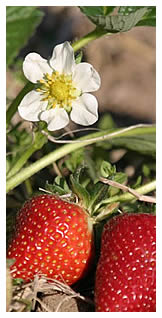 If
crops were actors and the farm had seasonal Oscar nominations, I think
strawberries would be the perennial superstars. In Spring they are the
first to raise the curtains for fruit season, and more impressively,
they will keep growing all season long, without interruption, until late
November. No fruit crop I know of, except maybe tropical bananas, comes
close to giving such a stellar performance every season. In late March,
when the first berries start ripening, I make it a habit to walk up and
down the rows. My main concern is checking for Two-spotted Spider Mites
which, once the weather gets warmer, can multiply explosively and are
difficult to keep in check. My other (and more rewarding) motivation
for walking the rows is to pick the first fully ripened sun-warmed strawberry.
By the end of winter, I yearn for that characteristically rich, tangy,
sweet, juicy flavor. Savoring that "perfect" first fruit triggers
in me a child-like joy, especially when accompanied by my 3 1/2 year
old daughter Elisa. However, this seemingly simple, almost elemental
pleasure also brings a deeper appreciation of the fruit’s complexity.
If
crops were actors and the farm had seasonal Oscar nominations, I think
strawberries would be the perennial superstars. In Spring they are the
first to raise the curtains for fruit season, and more impressively,
they will keep growing all season long, without interruption, until late
November. No fruit crop I know of, except maybe tropical bananas, comes
close to giving such a stellar performance every season. In late March,
when the first berries start ripening, I make it a habit to walk up and
down the rows. My main concern is checking for Two-spotted Spider Mites
which, once the weather gets warmer, can multiply explosively and are
difficult to keep in check. My other (and more rewarding) motivation
for walking the rows is to pick the first fully ripened sun-warmed strawberry.
By the end of winter, I yearn for that characteristically rich, tangy,
sweet, juicy flavor. Savoring that "perfect" first fruit triggers
in me a child-like joy, especially when accompanied by my 3 1/2 year
old daughter Elisa. However, this seemingly simple, almost elemental
pleasure also brings a deeper appreciation of the fruit’s complexity.Growing strawberries organically has many challenges. Every part of the plant, from its root tips to its leaves and berries, is vulnerable to being eaten or damaged by something. It's a formidable odyssey for a strawberry to end up in your hand unblemished.
We grow four different varieties: Seascape, Camarosa, Dulce, and Albion. As with most living organisms, much about strawberries is determined by their genetic make-up; most of the fruit and vegetables varieties we eat, for that matter, are the result of decades, if not centuries, of careful selection and breeding. Over the course of the season you will likely receive berries from each variety, and have the opportunity to experience their differences in flavor, shape, texture, and storability. Some have an early start, others spread their production over the entire season; some are firm, others are juicier and softer; and for us, the farmers, we like to see that they are resistant to pests and diseases and vigorous under different soil and climate conditions.
Not all aspects of strawberries are determined by genetics, especially when it comes to what is ultimately most important to us... flavor and taste. The subtleties of coaxing the best flavor out of a particular fruit or vegetable has a lot to do with a farm's specific soil and weather conditions. But equally important is how each farmer applies his or her experience implementing specific growing practices focused on enhancing flavor rather than yield. Last week's strawberry teaser was just a preview performance, with only enough strawberries for the Family shares. This week, however, with the warm weather we had, I am willing to stick my neck out and say everyone will get at least one basket.
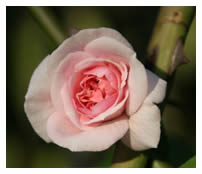 As I walked out of the house this morning to take pictures for the newsletter,
I spotted a beautiful rosebush with its first buds starting to open. While taking
a close-up shot, I noticed how similar the flower petals are to those of the
strawberry, and was reminded that so many of our favorite fruit – Apples,
Pears, Blackberries, Raspberries, Plums, and Quince – are related; they
all belong to the same mighty Rose or Rosacea family.
As I walked out of the house this morning to take pictures for the newsletter,
I spotted a beautiful rosebush with its first buds starting to open. While taking
a close-up shot, I noticed how similar the flower petals are to those of the
strawberry, and was reminded that so many of our favorite fruit – Apples,
Pears, Blackberries, Raspberries, Plums, and Quince – are related; they
all belong to the same mighty Rose or Rosacea family.Our relationship to food has been shaped over eons by our ancestors. It seems we as farmers and gardeners have an opportunity to revive and appreciate that seemingly lost connection.
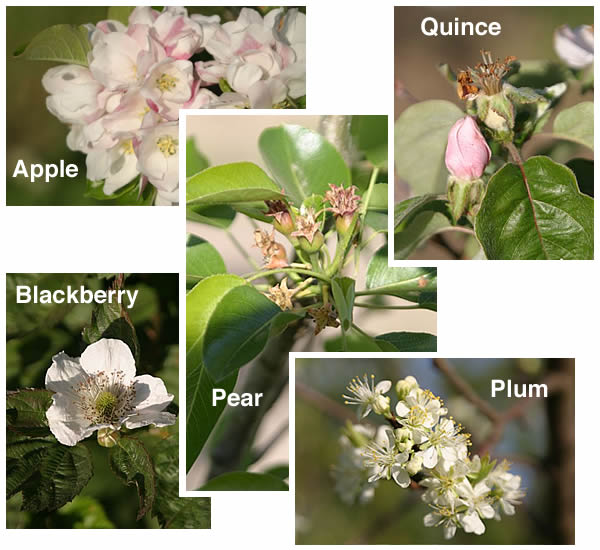
<back to top>
What's Up in the Fields
~~~~~~~~~~~~~~~~~~~~~~~~~~~~~~~~~~~~~~~~~~~~~~~~
Field chores and activities... the list is never ending! This week we are busy
getting everything ready to transplant our Pepper, Eggplant, and Tomato seedlings
from greenhouse to field. We are busy repairing and installing all of our water
and irrigation systems to give all the young tender seedlings a strong and healthy
start. Last week I was still concerned about frost; this past weekend we experienced
a record heat wave and everything needed watering. Most of our water is pumped
from wells through an arterial network of pipes to each field where it is then
directed to sprinkle or drip-irrigate any dry and thirsty crops. We are starting
to be busy with weeding, especially our direct sown crops, and a big block of
summer squash. The apricots are thinned and sizing up fast and most of our pears
have set a good crop. Now we are waiting for the apples to finish flowering before
deciding whether to thin or not. Potatoes are all pushing through the ground
and soon we'll need to keep a hawk’s eye on the gophers, who will be searching
for a free lunch by following the moist and freshly loosened soil down the rows.
The carrots in last week’s boxes were from our winter planting, but we
are running out of them (the spring planting is not sized up yet) already! Fortunately
Andy over at Mariquita Farm (one of the farms in Two Small Farms CSA -- our 'coopetition')
says he has a bumper crop, and so the Chantenay carrots in this week's boxes
are from his farm.
<back to top>
What's Up in the Farm Office
~~~~~~~~~~~~~~~~~~~~~~~~~~~~~~~~~~~~~~~~~~~~~~~~
It’s so easy to forget, in this Silicon Valley world of 24/7 customer service
and instant response time, that on the farm we do not have a staff of operators
standing by to deal immediately with changes to your share or questions you may
have. There is just me (Debbie), and I am generally on the farm, in the office
Tues/Weds/Fri. Mondays I’m home preparing the newsletter, and if my remote
internet connection is working (it’s been spotty all spring), I try to
check emails as well; Thursdays when I can, I check phone messages from home
and respond to emails too. But I process the brunt of messages and calls on Tues/Weds/Fri.
This past week was an exception, as I was out of town Thursday through the weekend,
only getting back Sunday afternoon (death in the family). Consequently I will
be a bit behind in responding to any emails or calls you may have sent during
that time. Please bear with me; I should be able to get to them all this week.
Under normal circumstances though, many of you already know I work hard to keep
my responses current and take care of you all as promptly as possible. But there
are some things which I need a little lead time to handle:
Donating your share or changing your pickup site: please call or email
me at the farm no later than Tuesday morning 9am, so that I can see that the
change gets into the reports for that week. Later than that, and I can’t
guarantee I’ll be able to make the change on time (though you know I’ll
try if I can).
Bigger changes - vacation or cancellation: please contact me at least
three weeks ahead of time if you want to stop your share (for four or more weeks)
or cancel. [Our policies
regarding refunds are stated on our website.]
<back to top>
Pictures around the farm
~~~~~~~~~~~~~~~~~~~~~~~~~~~~~~~~~~~~~~~~~~~~~~~~
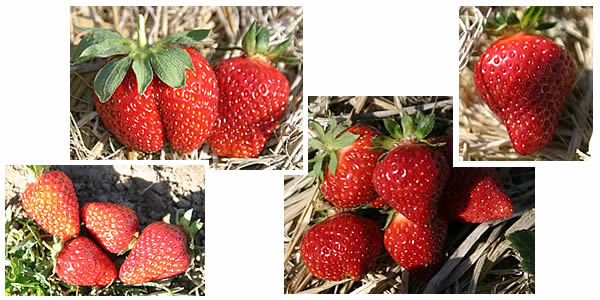
From left to right: Albions, Camarosas, Seascapes and Seascape again
(Tom's camera battery died before he could get a picture of the Dulces!).
The Camarosas, top left, tend to be broad and flattish, with a square
tip. Seeds are deeply indented in flesh. Flavor/texture is tangier/crunchier.
The Seascapes are rounder in girth, usually pointier tips with a bit
of a 'waistline' and seeds are more on the surface. They are red through
and through. Their flavor will vary over the season, though generally
sweet, and the berries get progressively smaller later in the season. Lower
left are the Albions; usually sweeter, straightforward round girth and
conical shape, seeds deeply indented. Albions will still be whitish inside
even when fully ripe. Dulce (not pictured) is a new variant we are trying
this year; similar to Camarosa, but supposed to be even sweeter. Berry
production proportions on the farm is roughly: 50% Seascapes, 25% Camarosas,
15% Albions and 10% Dulces.
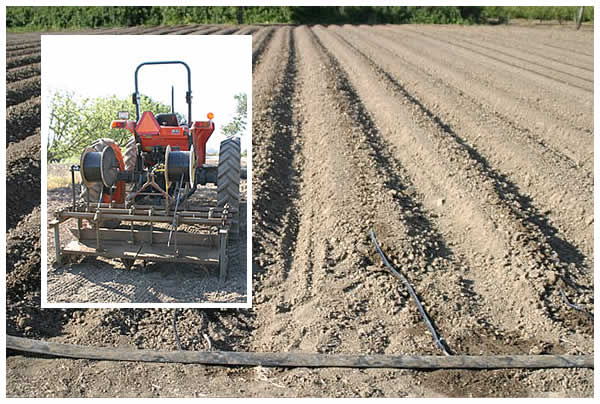
Recently shaped beds which have been newly set with driptape. Inset: tractor
with driptape spools; tractor wheels straddle two beds so that two lines
of tape can be laid at one time.
 Sprinkler
repair in-situ; thirsty seedlings getting a drink.
Sprinkler
repair in-situ; thirsty seedlings getting a drink.
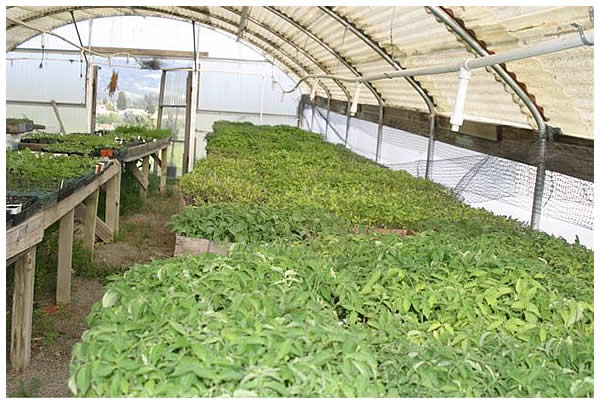
Here are the tomato (and other) seedlings ready and waiting to be planted
out into the fields this week.
What's in the box this week
~~~~~~~~~~~~~~~~~~~~~~~~~~~~~~~~~~~~~~~~~~~~~~~~
Content differences between Family and Small
Shares are in red; items
with a “+” in
Family Shares are more in quantity than in Small; anticipated quantities, if
any, are in parentheses. Occasionally content will differ
from this list (typically we will make a substitution), but we do our best to
give you an accurate projection.
Family Share:
White beets, topped and bagged
Broccoli [Lakeside Organic Farm] (2 - 3 stalks)
Chantenay carrots, topped and bagged [Mariquita Farm]
Chard
Fava Beans +
Green garlic
Kale
Lettuce +
Mei Qing Choi (6)
Young Onions (3)
Radishes
Strawberries (1 or 2 baskets)
Small Share:
Broccoli [Lakeside Organic Farm] (1 - 2 stalks)
Chantenay carrots, topped and bagged [Mariquita Farm]
Chard
Fava Beans
Green garlic
Lettuce
Mei Qing Choi (3)
Young Onions (2)
Radishes
Strawberries (1 basket)
Extra Fruit Option:
(doesn't start until May)
<back to top>
Notes from Debbie's Kitchen
~~~~~~~~~~~~~~~~~~~~~~~~~~~~~~~~~~~~~~~~~~~~~~~~
Click
here to go to recipe database
Mei Qing Choi
This is the new kid on the block this week! Tom tends to call it ‘bok
choi’ but technically this variety is called Mei Qing choi. The two are
totally interchangeable in recipes, so don’t be thrown off by the exotic-sounding
name. The flavor is quite similar (actually I’d have to do a blind taste
test to see if I could even tell them apart); most of the difference is in appearance:
bok choi has longer, whiter stems and dark green leaves (below left); mei qing
choi has pale green stems and round or oval, only slightly darker green leaves
(below right).
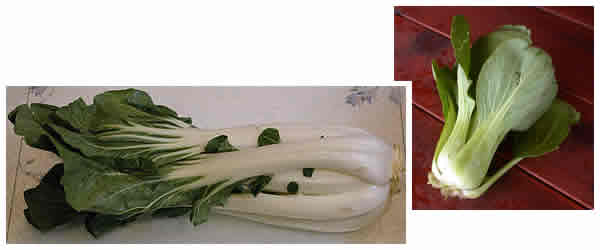
I discovered last year that I really love chopping and using mei qing choi raw
in tuna salad (or chicken salad or similar) in place of celery; the choi is more
tender than celery, but still provides crunch... a more delicate crunch, easier
to eat in a sandwich! And go ahead and chop up the leaves and throw them into
the mix too, or use the leaves instead of ‘lettuce’ when you assemble
your sandwich! Below is the chicken salad recipe I made up last year, to give
you an idea, but even in your basic can-o-tuna-plus-mayo, it is a great addition!
For that matter, try substituting mei qing choi in any recipe where you normally
would use celery. Variation on a theme!
Debbie’s Chicken Salad with Mei Qing (or Bok)
Choi
diced or shredded cooked chicken
diced choi
diced green onion (the tender, juicy green stems on the onions in your shares
can be used like scallions)
toasted chopped walnuts
bleu cheese (a little bit, crumbled)
plumped dried cranberries (soak ‘em in boiling water a few min.)
dressing (I’ll try to give you proportions; they’re not
exact measurements!):
a combo of walnut oil and flaxseed oil (or a plain canola if you don’t
have either of these) ~ 2 tbsp.
orange zest/oil* - zest from ½ to a whole orange, depending on how big
it is
dab of honey ~ ¼ to ½ tsp.
dab or Dijon mustard ~ ¼ to ½ tsp.
balsamic vinegar ~ 1 tbsp.
some mayonnaise ~ 1 ½ tbsp.
salt and pepper to taste
bed of lettuce or arugula for serving
Combine dressing ingredients. Toss chicken, choi, nuts, cheese and cranberries
with dressing, then serve individually, on beds of lettuce or arugula, or make
into a sandwich!
*here’s a trick: before making the dressing, zest the orange over the cup
you are going to make the dressing in. Point the orange/zester in such a way
that the orange oil that sprays out when you do the zesting is captured by the
cup along with the zest. Remove zest from cup, mince up, and return to cup; add
oils and swirl to mix – the orange oil will then commingle with the other
oils and enhance the overall flavor!
Fava Beans, continued
I talked about young favas last week, but of course over time the
pods will get bigger, as will the beans inside, so you’ll want some sort
of gauge for when to eat them pods and all, and when to switch to shucking the
pods and only eating the beans inside. A rule of thumb (finger?) is that, when
they are still roughly the diameter of your finger and bright, vibrant green,
definitely eat them pods and all. As they get bigger, if the pods are still bright
and the beans within fairly small still, you can kind of go either way. Once
the pods and inner beans get big, the pods are tough. It’s best at this
point to shuck them and only use the beans. Some weeks you’ll get bags
with big and small pods inside; just sort them and use them accordingly. [Click
here to see the comparative photos that are in the recipe database.]
Now there’s another optional step when working with the beans inside: removing
the pale green skin. This is easily done, although it can be somewhat labor intensive.
Simply drop the beans into boiling water for a minute or so, then lift them out
with a slotted spoon (or drain them); the skin will have loosened. Now just pinch
the skin on one end of the bean, and give it a squeeze on the other. The bean
will squirt out through the pinched opening (have a bowl handy to receive!).
There’s no requirement to peel the inner bean though (unless your making
a mash or spread with them); taste them both ways and see. If you don’t
mind the skins, just leave ‘em on!
My favorite thing to do with the beans right after they’re peeled and still
warm, is to simply salt them and eat them like edamame, but there are also several
ways to cook with them at this point. They will be in our boxes for a few weeks
yet so I’ll have more recipes accordingly. Here’s one that sounds
fancy but the preparation is pretty simple.
Sliced Filet Mignon with Fava Beans, Radishes, and Mustard Dressing
adapted from a Bon Appetit clipping, April 2006
[photo credit: Tina Rupp, Bon Appetit Magazine]
Serves 4
4 small filet mignon steaks [I’m aware that the economy is not such that
many of us can afford filet mignon; I’d substitute any decent grassfed
beef steak, it doesn’t have to be filet mignon!]
1 tbsp. ea. butter and canola oil
3 tbsp. apple cider vinegar
2 tsp. Dijon mustard
¼ C extra-virgin olive oil
2 C [more or less] cooked, peeled fava beans [see above]
10 medium radishes, very thinly sliced
¼ C chopped fresh herbs (such as tarragon, basil, thyme and parsley)
1/3 C crumbled feta cheese
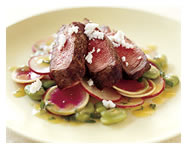 Whisk vinegar and mustard in small bowl. Gradually whisk in olive oil. Season
to taste with salt and pepper. Combine beans, radishes, herbs and dressing; toss
to coat. Season with salt and pepper. Let salad stand at room temperature at
least 20 minutes and up to 1 hour.
Whisk vinegar and mustard in small bowl. Gradually whisk in olive oil. Season
to taste with salt and pepper. Combine beans, radishes, herbs and dressing; toss
to coat. Season with salt and pepper. Let salad stand at room temperature at
least 20 minutes and up to 1 hour.
Sprinkle steaks with salt and pepper. Melt butter with oil in heavy large skillet
over high heat. Add steaks to skillet and cook to desired doneness, about 4 minutes
per side for medium-rare. [Alternatively you could grill your steaks.] Transfer
to a cutting board and slice.
Divide salad among 4 plates. Arrange sliced steak atop salads. Sprinkle cheese
over each and serve.
Carrot Salad with Creamy Lemon, Yogurt and Chive Dressing
Another Bon Appetit clipping
4 to 6 servings
2 tbsp. fresh lemon juice [juice from about half a lemon]
1 tsp. honey
3 tbsp. extra-virgin olive oil
¾ C plain whole-milk yogurt (preferably Greek-style) [that means thick]
3 C coarsely grated peeled carrots
¼ C chopped fresh chives
¼ C sliced almonds, toasted
Whisk lemon juice and honey in medium bowl. Gradually whisk in oil, then yogurt.
Mix in carrots and chives. Season with salt and pepper. Cover and chill. Stir
before serving. Sprinkle with toasted sliced almonds before serving.
Quelites (Greens with Pinto Beans)
from Great American Vegetarian, by Nava Atlas
serves 4 to 6
From the cookbook: “Originally, the Pueblo Indians of the Southwest made
this dish with wild greens. More contemporary recipes call for spinach or chard
instead. The dark greens look very appealing with the pink beans, and the more
garlicky you make it, the better.”
1 lb. Chard or spinach
1 ½ tbsp. olive oil
2 or 3 garlic cloves [or one to two whole stalks of green garlic!]
3 scallions, white and green parts, finely chopped [again, the fresh young onions,
the pale and medium green parts of the stems, can be chopped and used just like
you would scallions]
1 to 1 ½ C cooked or canned pinto beans
1 tsp. chili powder
Salt and freshly ground black pepper
Stem and wash the greens and coarsely chop the leaves. If you’re using
chard, trim away the thick midribs and thinly slice them. Steam with a very small
amount of water in a large, tightly covered soup pot until wilted. The spinach
will be done as soon as it wilts; the chard needs to steam a bit longer. It will
be done when it turns a deep green. Drain the greens and finely chop them.
Heat oil in a large skillet. Add the garlic and sauté over low heat until
it just begins to turn golden. Add the scallions and sauté just until
they soften a bit. Stir in the greens, beans, and seasonings. Cook, covered,
over low heat for 5 minutes, or just until everything is heated through.
Roasted Broccoli with Asiago
undated clipping; magazine unknown
serves 4
“Roasting broccoli brings out its earthy sweetness, and sprinkling it with
cheese will guarantee that the kids clean their plates,” says the opening
line.
1 ½ lbs. broccoli (about 1 lg. bunch), stalks trimmed to 2 inches below
the crowns [don’t chuck the fat stalks! you can peel them and cut them
into segments, then lengthwise into pieces]
3 tbsp. olive oil
1 C grated Asiago cheese [a different hard-grating cheese will substitute just
fine I’m sure]
Preheat oven to 450 degrees. Cut each crown of broccoli lengthwise into 4 spears.
Place broccoli in a large bowl; toss with olive oil and sprinkle with salt and
pepper. Transfer broccoli to a large rimmed baking sheet. Add grated Asiago to
same bowl. Roast broccoli until crisp-tender and stalks begin to brown, about
25 minutes. Return broccoli to bowl with cheese. Using tongs, toss to coat.
<back to top>
2008 Calendar of Events
~~~~~~~~~~~~~~~~~~~~~~~~~~~
For details on events listed
below, please Click
here to go to the calendar page on our website.
Santa Cruz Permaculture Design course - one weekend/month for
6 months, Feb-July
Spring "Six Thursdays" Mataganza Garden Internship - every
Thursday from May 1st through June 5th in the Mataganza Garden Sanctuary
at Live Earth Farm.
Herbalism Classes at Live Earth Farm:
<>Herbal First Aid - March 15-16
<>Medicine Making - May 10-11
<> Cooking with Herbs - July 19-20
Summer Solstice Celebration - Saturday June 21st
Children's Mini-Camp - July 11th - 13th (Friday evening thorugh Sunday
noon)
Fall Equinox Cob Building Workshop and Campout - Sept. 20 and 21
Fine Farm Feast - Oct 4th
Fall Harvest Celebration - later in October (date TBA)
Contact Information
~~~~~~~~~~~~~~~~~~~~~~~~~~~
email Debbie at the farm (for any farm or CSA share-related business): farmers@cruzio.com
email Debbie at home (with newsletter input or recipes): deb@writerguy.com
farm phone: 831.763.2448
website: http://www.liveearthfarm.net
~~~~~~~~~~~~~~~~~~~~~~~~~~~